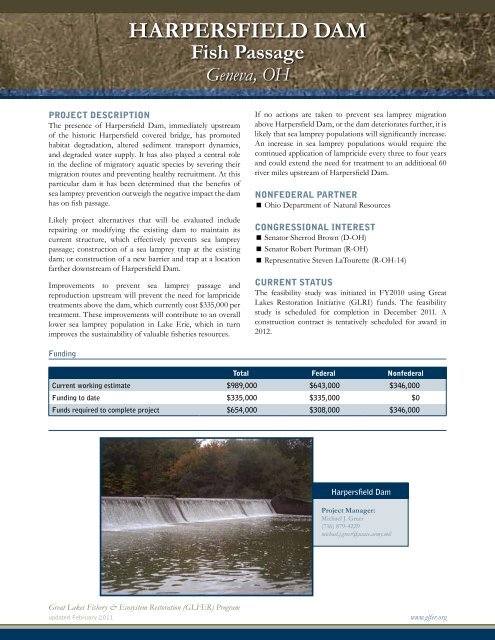Great Lakes Fishery and Ecosystem Restoration Program Project ...
Great Lakes Fishery and Ecosystem Restoration Program Project ...
Great Lakes Fishery and Ecosystem Restoration Program Project ...
You also want an ePaper? Increase the reach of your titles
YUMPU automatically turns print PDFs into web optimized ePapers that Google loves.
HARPERSFIELD DAM<br />
Fish Passage<br />
Geneva, OH<br />
ProjECt DESCriPtion<br />
The presence of Harpersfield Dam, immediately upstream<br />
of the historic Harpersfield covered bridge, has promoted<br />
habitat degradation, altered sediment transport dynamics,<br />
<strong>and</strong> degraded water supply. It has also played a central role<br />
in the decline of migratory aquatic species by severing their<br />
migration routes <strong>and</strong> preventing healthy recruitment. At this<br />
particular dam it has been determined that the benefits of<br />
sea lamprey prevention outweigh the negative impact the dam<br />
has on fish passage.<br />
Likely project alternatives that will be evaluated include<br />
repairing or modifying the existing dam to maintain its<br />
current structure, which effectively prevents sea lamprey<br />
passage; construction of a sea lamprey trap at the existing<br />
dam; or construction of a new barrier <strong>and</strong> trap at a location<br />
farther downstream of Harpersfield Dam.<br />
Improvements to prevent sea lamprey passage <strong>and</strong><br />
reproduction upstream will prevent the need for lampricide<br />
treatments above the dam, which currently cost $335,000 per<br />
treatment. These improvements will contribute to an overall<br />
lower sea lamprey population in Lake Erie, which in turn<br />
improves the sustainability of valuable fisheries resources.<br />
Funding<br />
If no actions are taken to prevent sea lamprey migration<br />
above Harpersfield Dam, or the dam deteriorates further, it is<br />
likely that sea lamprey populations will significantly increase.<br />
An increase in sea lamprey populations would require the<br />
continued application of lampricide every three to four years<br />
<strong>and</strong> could extend the need for treatment to an additional 60<br />
river miles upstream of Harpersfield Dam.<br />
nonfEDErAl PArtnEr<br />
Ohio Department of Natural Resources<br />
CongrESSionAl intErESt<br />
Senator Sherrod Brown (D-OH)<br />
Senator Robert Portman (R-OH)<br />
Representative Steven LaTourette (R-OH-14)<br />
CUrrEnt StAtUS<br />
The feasibility study was initiated in FY2010 using <strong>Great</strong><br />
<strong>Lakes</strong> <strong>Restoration</strong> Initiative (GLRI) funds. The feasibility<br />
study is scheduled for completion in December 2011. A<br />
construction contract is tentatively scheduled for award in<br />
2012.<br />
Total Federal Nonfederal<br />
current working estimate $989,000 $643,000 $346,000<br />
funding to date $335,000 $335,000 $0<br />
funds required to complete project $654,000 $308,000 $346,000<br />
harpersfield Dam<br />
<strong>Project</strong> Manager:<br />
Michael J. Greer<br />
(716) 879-4229<br />
michael.j.greer@usace.army.mil<br />
<strong>Great</strong> <strong>Lakes</strong> <strong>Fishery</strong> & <strong>Ecosystem</strong> <strong>Restoration</strong> (GLFER) <strong>Program</strong><br />
updated February 2011 www.glfer.org


